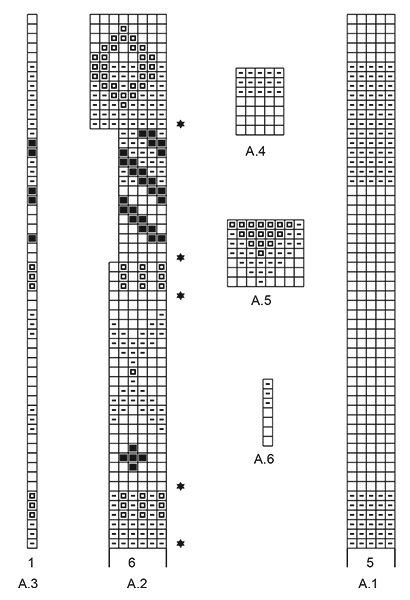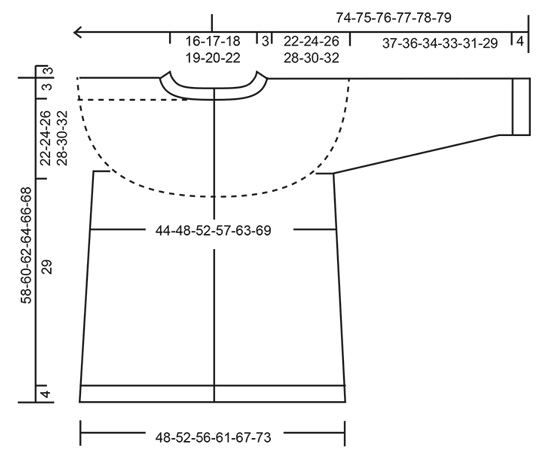Crisp Air Jacket |
||||||||||||||||
 |
 |
|||||||||||||||
Knitted jacket with round yoke and Nordic pattern in DROPS Karisma. The piece is worked top down. Sizes S - XXXL.
DROPS 207-13 |
||||||||||||||||
|
------------------------------------------------------- EXPLANATIONS FOR THE PATTERN: ------------------------------------------------------- RIDGE/GARTER STITCH (worked back and forth): Knit all rows. 1 ridge in height = Knit 2 rows. ELEVATION (back of neck): So the jacket is slightly higher at the back of the neck when working a round yoke, you can work an elevation as described here. Skip this section if you do not want an elevation; the neck will then be the same front and back. Insert 1 marker in the middle of the row = mid back. Start from the right side and knit 14-15-16-16-17-18 stitches past the marker, turn, tighten strand and purl 28-30-32-32-34-36 stitches back. Turn, tighten strand and knit 42-45-48-48-51-54 stitches, turn, tighten strand and purl 56-60-64-64-68-72 stitches back. Turn, tighten strand and knit to end of row (band worked in garter stitch), turn, tighten strand and purl to end of row (band worked in garter stitch). Then work YOKE as described in the text. PATTERN: See diagrams A.1 to A.6. The diagrams show all rows in the pattern seen from the right side. BANDS: The first and last 5 stitches on each row are worked in garter stitch; when working patterns A.2/A.3 the bands are worked in A.1. When working patterns A.5/A.6 the bands are worked in A.4. INCREASE TIP-1 (evenly spaced): To work out how to increase evenly, count the total number of stitches on the needle (e.g. 108 stitches) minus bands (e.g. 10 stitches) and divide the remaining stitches by the number of increases to be made (e.g. 29) = 3.4. In this example, increase by making 1 yarn over after alternately each 3rd and 4th stitch. Do not increase on bands. On the next row work the yarn overs twisted to avoid holes. INCREASE TIP-2 (for sides of body): All increases are worked from the right side! Work until there are 2 stitches left before the marker thread, make 1 yarn over, knit 4 (marker thread sits between these 4 stitches) make 1 yarn over (= 2 stitches increased at each marker thread; 4 stitches increased on row). On the next row purl the yarn overs twisted to avoid holes. Then work the new stitches in stocking stitch. DECREASE TIP (for sleeves): Decrease 1 stitch on each side of the marker thread as follows: Work until there are 3 stitches left before the marker thread, knit 2 together, knit 2 (marker thread sits between these 2 stitches), slip 1 stitch as if to knit, knit 1 and pass the slipped stitch over the knitted stitch. BUTTONHOLES: Work buttonholes on the right band (when the garment is worn). Work from the right side when there are 3 stitches left on the row as follows: Make 1 yarn over, knit 2 together and knit 1. On the next row (wrong side), knit the yarn over to leave a hole. The first buttonhole is worked when the rib on the neck measures 2 cm. Then work the other 6-6-6-7-7-7 buttonholes with approx. 8½-9-9-8-8½-9 cm between each one. ------------------------------------------------------- START THE PIECE HERE: ------------------------------------------------------- JACKET – SHORT OVERVIEW OF THE PIECE: The piece is worked back and forth with circular needle, top down. The sleeves are worked in the round with short circular needle/ double pointed needles. NECK: Cast on 108-112-116-120-124-132 stitches with circular needle size 3.5 mm and sea green. Purl 1 row from the wrong side. Change to light grey green and work rib from the right side as follows: Work 5 band stitches in GARTER STITCH – read description above, (knit 2/ purl 2) until there are 7 stitches left on the row, knit 2 and finish with 5 band stitches in garter stitch. Continue this rib back and forth for 3 cm. Insert a marker here. THE PIECE IS MEASURED FROM HERE. Change to circular needle size 4.5 mm. Now you can work an ELEVATION in the back of the neck – read description above. If you do not want an elevation go straight to YOKE. YOKE: Work pattern back and forth as follows: Work 5 band stitches in garter stitch – read BANDS, work A.2 until there are 6 stitches left on the row, A.3 over the next stitch and 5 band stitches in garter stitch, AT THE SAME TIME on each row marked with a star increase as follows: STAR-1: Increase 29-31-33-35-37-41 stitches evenly spaced – read INCREASE TIP-1 = 137-143-149-155-161-173 stitches (there is now room for 21-22-23-24-25-27 repeats of A.2 with 6 stitches). REMEMBER THE KNITTING TENSION! STAR-2: Increase 42-42-48-48-48-48 stitches evenly spaced = 179-185-197-203-209-221 stitches (there is now room for 28-29-31-32-33-35 repeats of A.2 with 6 stitches). STAR-3: Increase 48-54-54-60-60-60 stitches evenly spaced = 227-239-251-263-269-281 stitches (there is now room for 36-38-40-42-43-45 repeats of A.1 with 6 stitches). STAR-4: Increase 29-42-45-48-52-60 stitches evenly spaced = 256-281-296-311-321-341 stitches (there is now room for 49-54-57-60-62-66 repeats of A.2 with 5 stitches). STAR-5: Increase 27-34-43-44-50-54 stitches evenly spaced = 283-315-339-355-371-395 stitches (there is now room for 34-38-41-43-45-48 repeats of A.2 with 8 stitches). When there is 1 row left in the diagram the piece measures approx. 22 cm from the marker. Continue as follows in the different sizes: In size S skip the next section and continue from All sizes – below. Sizes M, L, XL, XXL and XXXL: Continue with pattern A.5 over A.2, A.6 over A.3 and the bands in garter stitch and colours as shown in A.4. When the diagrams have been completed in height the piece measures approx. 24 cm from the marker. Size M is now finished (unless it is shorter than 24 cm, in which case continue with stocking stitch and sea green to this measurement). In sizes L, XL, XXL and XXXL continue with stocking stitch, sea green and the band stitches in garter stitch on both sides towards mid front until the piece measures 26-28-30-32 cm from the marker, AT THE SAME TIME when the piece measures 27-28-29-30 cm (from the marker), increase 0-11-19-27 stitches evenly spaced = 339-366-390-422 stitches. All sizes: Work the last row on the yoke as follows: Work the first 45-49-52-57-62-68 stitches (= right front piece), place the next 56-64-70-74-76-80 stitches on 1 thread for sleeve, cast on 8-8-10-10-12-12 new stitches on the needle (= in side under sleeve), work the next 81-89-95-104-114-126 stitches (= back piece), place the next 56-64-70-74-76-80 stitches on 1 thread for sleeve, cast on 8-8-10-10-12-12 new stitches on the needle (= in side under sleeve), work the remaining 45-49-52-57-62-68 stitches on the row (= left front piece). Body and sleeves are finished separately. THE PIECE IS NOW MEASURED FROM HERE. BODY: There are 187-203-219-238-262-286 stitches on the body. Insert 1 marker thread in each side in the middle of the 8-8-10-10-12-12 new stitches cast on under both sleeves (= 4-4-5-5-6-6 new stitches on each side of the threads). In size S continue as described below; in sizes M, L, XL, XXL and XXXL skip the next section and continue from ALL SIZES below. Size S: Work pattern as follows: Work the 5 band stitches in garter stitch and pattern A.4, work A.5 over each repeat of A.2 until there are 6 stitches left on the row and finish with 5 band stitches in garter stitch and pattern A.4. Continue back and forth like this until the diagrams have been completed in height. Then continue from ALL SIZES below. ALL SIZES: Continue back and forth with sea green, stocking stitch and 5 band stitches in garter stitch on each side. When the piece measures 4 cm, increase 1 stitch on both sides of each marker thread in the sides – read INCREASE TIP-2. Increase like this every 7 cm a total of 4 times = 203-219-235-254-278-302 stitches. When the piece measures 29 cm, increase 37-41-45-50-54-58 stitches evenly spaced = 240-260-280-304-332-360 stitches. Change to circular needle size 3.5 mm and work rib from the right side as follows: 5 band stitches in garter stitch, (knit 2/ purl 2) until there are 7 stitches left on the row, knit 2 and finish with 5 band stitches in garter stitch. When the rib measures 4 cm cast off with knit over knit and purl over purl. Make sure the cast-off edge is not tight; increase a needle size when casting off, if this is a problem. The jacket measures approx. 58-60-62-64-66-68 cm from the shoulder down. SLEEVE: Place the 56-64-70-74-76-80 stitches from the thread on the one side of the piece on short circular needle/double pointed needles size 4.5 mm and knit up 1 stitch in each of the 8-8-10-10-12-12 stitches cast on under the sleeve = 64-72-80-84-88-92 stitches. In size S work pattern as described below; the other sizes are continued from section ALL SIZES below. Size S: Start the round before the 8 new stitches under the sleeve and work A.2 over each repeat of A.1 (from the yoke). When A.2 has been completed in height continue from ALL SIZES below. ALL SIZES: Insert a marker thread in the middle of the new stitches under the sleeve (= 4-4-5-5-6-6 new stitches on each side of the thread). Work stocking stitch in the round with sea green. When the piece measures 4-4-4-3-3-3 cm, decrease 1 stitch on each side of the marker thread – read DECREASE TIP. Decrease like this every 3-2-1½-1½-1½-1 cm a total of 11-14-17-18-19-20 times = 42-44-46-48-50-52 stitches. When the sleeve measures 37-36-34-33-31-29 cm (shorter measurements in larger sizes due to longer yoke), increase 6-8-10-8-10-8 stitches evenly spaced = 48-52-56-56-60-60 stitches. Change to double pointed needles size 3.5 mm and work rib (= knit 2/ purl 2) for 4 cm. Cast off with knit over knit and purl over purl. Make sure the cast-off edge is not tight; increase a needle size when casting off, if this is a problem. The sleeve measures approx 41-40-38-37-35-33 cm. Work the other sleeve in the same way. |
||||||||||||||||
Diagram explanations |
||||||||||||||||
|
||||||||||||||||

|
||||||||||||||||

|
||||||||||||||||
|
Have you made this or any other of our designs? Tag your pictures in social media with #dropsdesign so we can see them! Do you need help with this pattern?You'll find tutorial videos, a Comments/Questions area and more by visiting the pattern on garnstudio.com. © 1982-2024 DROPS Design A/S. We reserve all rights. This document, including all its sub-sections, has copyrights. Read more about what you can do with our patterns at the bottom of each pattern on our site. |
||||||||||||||||

































































Comments / Questions (9)
Je vous remercie de votre réponse rapide. Je me demandais s'il fallait faire une taille au dessus mais un deuxième échantillon m'a rassurée. Je continue mon ouvrage qui est de plus en plus joli.
23.06.2020 - 18:59Bonjour! Je suis embrouillée avec les mesures du gilet. Si 20 mailles donnent 10 cm, les 304 mailles devraient donner 150 cm au lieu de 122 cm indiqué pour la taille XL.
23.06.2020 - 13:10DROPS Design answered:
Bonjour Mme Zelina, les 304 mailles se tricotent en côtes avec les petites aiguilles = il faut plus de mailles qu'en jersey avec les grandes aiguilles - en XL vous terminez par 254 mailles soit 127 cm / 2 - les bordures des devants = env. 61 cm. Bon tricot!
23.06.2020 - 16:21When will this jacket be published? It’s my favourite, the yarns are waiting😘😙
20.08.2019 - 19:17Lovely colours. I really want to make this!!!
07.07.2019 - 18:28Flot, skønne farver også.
19.06.2019 - 23:441A, gefällt mir beides, Jacke und Pulli :-)
17.06.2019 - 10:28My vote, elegant, colourband can be repeated on hips
09.06.2019 - 21:20Da stimmt Alles!Wird auf alle Fälle gestrickt!
06.06.2019 - 09:19Favorece ese canesú
05.06.2019 - 20:21